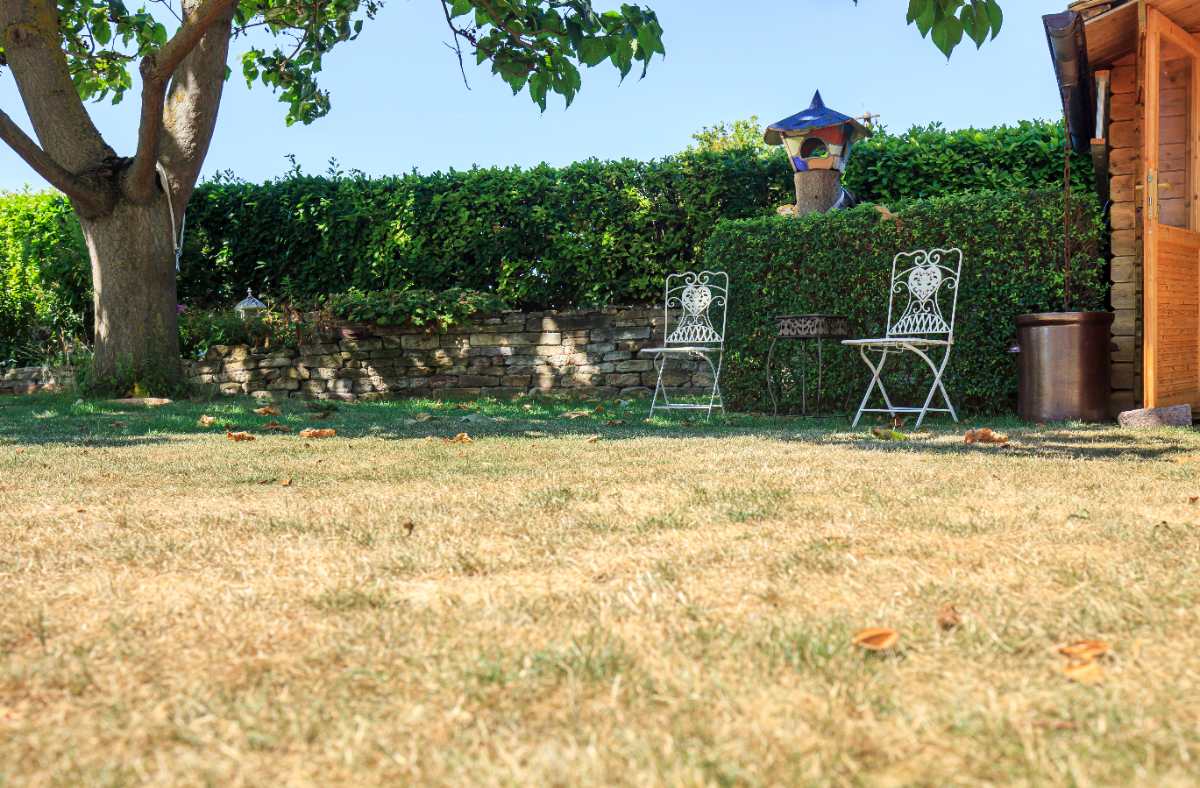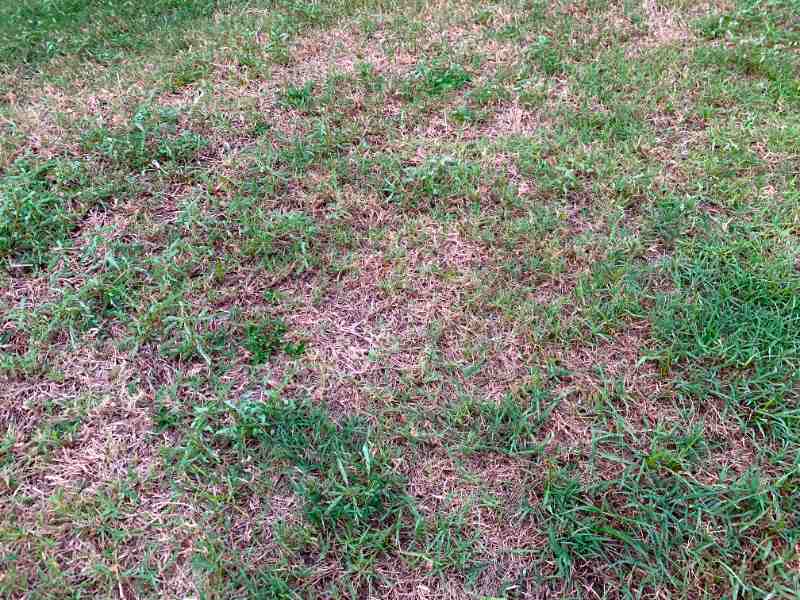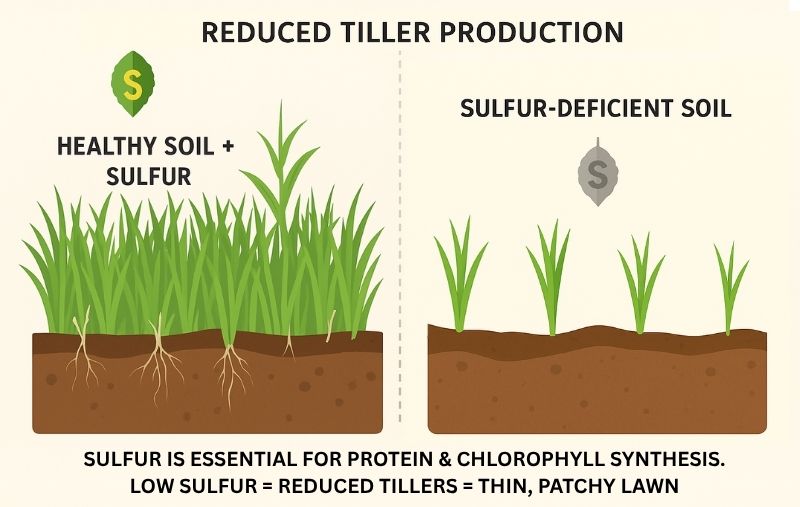
If your lawn is suffering from yellowing of new growth, stunted growth, poor root development, and delayed spring greenup, these are all signs your lawn may need sulfur.
Adding sulfur will help lower the pH level of alkaline soil. And a balanced soil pH can make a lot of difference in your lawn’s health. So, be on the lookout for the following tell-tale signs of sulfur deficiency, or hire a pro to assess your lawn for you.
Yellowing of New Growth
“A lack of nitrogen can cause yellowing in new growth,” says Brad Stokes, associate professor of horticulture at the University of Idaho Extension. A lack of “sulfur can also mimic this yellowing in young plants when it is not available in the soil profile.”
Sulfur can be considered the fourth macronutrient (alongside nitrogen, phosphorus, and potassium) for plant growth and development, Stokes adds. “It is a vital nutrient for the creation of amino acids, proteins, and chlorophyll production.”
So, when fresh grass blades appear pale, light green, or even yellow, it may be a sign of alkaline soil. Since sulfur is vital for chlorophyll formation, new growth will show stress before the existing grass.
To turn the pale grass blades back to green, you can lower the soil pH by using elemental sulfur or synthetic sulfur (like iron sulfate or aluminum sulfate). But before applying a soil acidifier, you must first test your soil to determine if its pH level is too alkaline and actually lacks sulfur.
Pro Tip: Aim for a soil pH between 6 and 7 for ideal nutrient uptake, unless your soil is naturally alkaline.
Naturally alkaline soils (common in sandy, arid regions of the Western U.S.) contain high levels of lime, giving them a natural pH of around 7.5 to 8.3. In alkaline soils, it’s best to work with your soil, planting grass that is well adapted to your area, rather than trying to make major adjustments with sulfur amendments.
Stunted Growth
Without enough sulfur, your lawn can’t convert nitrogen into proteins, leading to stunted growth. So, if your lawn doesn’t seem to be growing, even during its active growing season, it may be suffering from sulfur deficiency. Your grass may appear short, thin, and weak.
Apart from thinning spots and bare patches, you may also notice the following:
- Dull or lifeless color: Your grass may lack its usual vibrancy.
- Shallow root system: Grass roots less than 2 inches deep may struggle to absorb nutrients.
- Slow to recover from foot traffic: Weak grass will be unable to bounce back quickly, even if you have one of the best grasses for high-traffic yards.
Using a sulfur fertilizer helps kickstart growth by improving photosynthesis efficiency and amino acid synthesis.
Note: Research by the University of Tennessee states that a 15:1 nitrogen-to-sulfur (N:S) ratio is considered normal in turfgrasses with no nutrient deficiency, with sulfur levels typically ranging from 0.1% to 0.6%.
See Related: When is the Best Time to Apply Sulfur to Your Lawn
Poor Root Development

Stokes also mentions that, like nitrogen, a lack of sulfur can limit or stunt proper growth and development.
If your lawn struggles to anchor itself, producing weak or shallow roots, sulfur deficiency may be the problem. With a poor root system, the grass will be easy to pull out. It can also cause the following:
- Thin, dry, or patchy growth
- An increase in weeds
- Soil compaction
- Standing water
Grass roots are easily affected by nutrient imbalances, and sulfur plays a direct role in developing strong and deep root systems. Since it converts nitrogen into proteins necessary for strong root development, a lack of sulfur will cause excessive nitrogen to push top growth at the expense of a healthy root system.
See Related:
Reduced Tiller Production

Grass spreads primarily through rhizomes and stolons, but tillers are new grass shoots that increase the density and thickness of lawns.
However, the grass won’t be able to produce new shoots if the soil has insufficient sulfur levels (since it’s essential for protein and chlorophyll synthesis).
If your lawn is low in tillers, it will be thin, patchy, and less resilient to stress.
Delayed Spring Greenup
The cold and wet soil conditions in early spring can make sulfur less available to the grass roots. Even if your soil is not sandy, winter rain or melting snow can wash out the sulfur.
If your lawn is taking longer than usual to turn green in the spring, it may be a sign of sulfur deficiency. Sulfur helps kickstart grass growth after winter dormancy. And, without it, the transition of your lawn from dormant brown to vibrant green will be sluggish.
Adding sulfur can help:
- Jumpstart photosynthesis for a faster greenup
- Ensure efficient use of nitrogen for spring growth
- Provide enzymes and proteins needed to break dormancy
- Promote a stronger recovery and prepare the grass for summer
See Related:
Increased Susceptibility to Disease
Sulfur deficiency can increase your lawn’s susceptibility to diseases. This nutrient is vital for creating compounds that help your grass resist pathogens. So, insufficient amounts will weaken the tissues and natural defenses of your grass.
If your lawn is lacking sulfur, it will look weak and be more prone to fungal problems and common lawn diseases.
When supplied in proper amounts, sulfur supports grass health and resilience in several ways, including:
- Builds stronger cell walls that resist infection
- Fuels processes that protect against pathogens
- Supports balanced growth, reducing stress on the grass
- Helps healthy plants recover faster from minor outbreaks
Poor Response to Nitrogen Fertilizer
Sulfur is essential for unlocking the benefits of nitrogen, ensuring your lawn gets the full payoff from fertilization. So, if you’ve applied nitrogen but your lawn still isn’t greening up or growing well, the problem might be sulfur deficiency. Since it’s closely tied to how effectively grass uses nitrogen, without sulfur, fertilizer results fall flat.
“Both nitrogen and sulfur are mobile nutrients within the plant’s vascular system,” shares Stokes. “The uptake is very similar, and the presence of sulfur in the right ratios can help stabilize some specific forms of nitrogen in the soil profile.”
So, when inadequate amounts of sulfur limit the conversion of nitrogen into usable proteins, it can lead to an imbalanced fertilization. Sulfur can help maximize nutrient synergy and fertilizer efficiency, giving you better results with less waste.
Pro Tip: Collecting your grass clippings may also contribute to sulfur deficiency in soils with low organic matter (like sandy soils). Leave your grass clippings on the lawn to reduce the severity of naturally low sulfur levels and give your lawn a boost of nitrogen.
FAQ About Sulfur Deficiency
Clay soils tend to hold sulfur longer, making it available to grass roots over time. Sandy soils, on the other hand, drain quickly and leach sulfur, meaning lawns with sandy soils are more likely to experience a deficiency.
Yes. Lawns low in sulfur are often weaker or thinner because the blades don’t form strong tissues. Instead of being dense and firm, the grass may feel soft, flimsy, and less resilient under foot traffic or mowing.
Sulfur deficiency is often a problem in early spring when grass is trying to green up. Cool, wet soils make sulfur less available, and heavy winter rains often leach it from the soil, leaving grass slow to recover after dormancy.
Yes, watering extremes can hide or worsen sulfur issues. Over-watering washes sulfur out of the soil, while under-watering stresses grass so severely that yellowing or poor growth could be mistaken for drought rather than nutrient deficiency.
Add Sulfur if Your Lawn Needs It
Catching the early signs of sulfur deficiency can make all the difference in your lawn’s health. If your lawn seems lackluster despite fertilization, it may be time to consider its sulfur needs. For best results, hire a local lawn treatment pro who can diagnose soil issues and apply the right amendment to keep your lawn green and thriving.
Sources:
- “Adjusting Soil pH in the Garden.” University of California Agriculture and Natural Resources.
- Brad Stokes, associate professor of horticulture at the University of Idaho Extension. Personal interview.
- “Changing pH in Soil.” By Paul Vossen, farm advisor. University of California Cooperative Extension.
- “Do Garden Soils Need Limestone or Sulfur?” By Bruce Spangenberg, horticulture outreach specialist. University of Wisconsin-Madison Extension.
- “Fertilizing Lawns.” By Tom Cook, emeritus professor, and Brian McDonald, senior faculty research assistant. Oregon State University Extension.
- “Nutrient Deficiencies in Turf.” Yara North America.
- “Sulfur Fertility Management for Grain and Forage Crops.” By Charlie White, assistant professor, John Spargo, director, Hanna Wells, Extension associate, Zachary Sanders, former research technologist, Tyler Rice, former research associate, and Doug Beegle, emeritus professor. Penn State University.
- “The Use of Sulfur in Turfgrass Management.” By Nick Christians. Landscape Management.
- “Turfgrass Maintenance Essential Elements.” By Tom Samples, professor, John Sorochan, associate professor, and Hugh Savoy, associate professor. University of Tennessee.
Main Image: If your lawn becomes dry and patchy, it may need sulfur. Image Credit: ImageSine / Adobe Stock